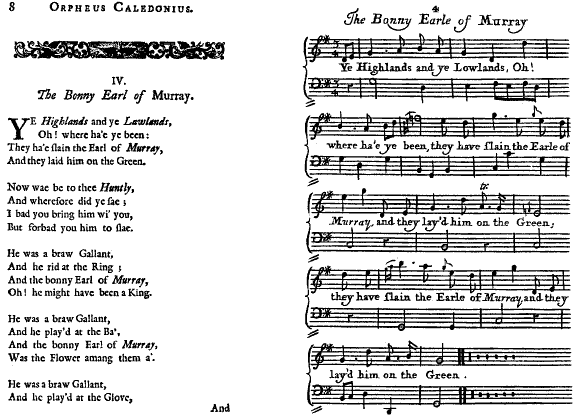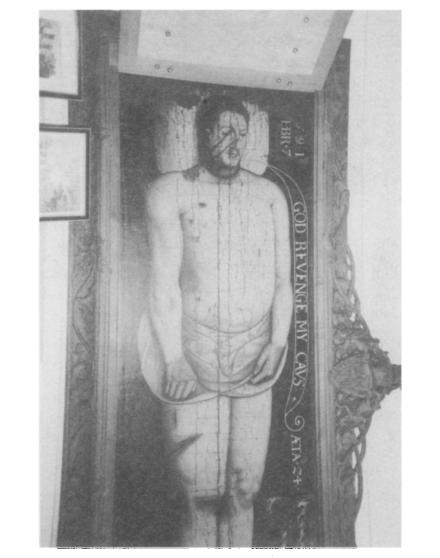181. The Bonnie Earl o' Moray
[There are several great articles attached to the Recording & info page including "The Bonny Earl of Murray": The Ballad as History and the best article, The Dreadful Death of the Bonny Earl of Murray: Clues from the Carpenter Song Collection. Additonally a book was publiched in 1997 by Edward D. Ives entitled, Bonny Earl of Murray: The Man, the Murder, and the Ballad.
R. Matteson 2012]
1733 Version- not included by Child in his narrative

CONTENTS:
1. Child's Narrative
2. Footnotes (Found at the end of Child's Narrative)
3. Brief (Kittredge)
4. Child's Ballad Texts A-B
5. "Additions and Corrections"
ATTACHED PAGES (see left hand column):
1. Recordings & Info: 181. The Bonnie Earl o' Moray
A. Roud No. 334: The Bonny Earl of Murray (53 Listings)
B. 'Dreadful Death of Bonny Earl of Murray' Review
C. "The Bonny Earl of Murray": The Ballad as History
D. The Dreadful Death of the Bonny Earl of Murray: Clues from the Carpenter Song Collection
2. Sheet Music: 181. The Bonnie Earl o' Moray (Bronson's music examples and texts)
3. US & Canadian Versions
4. English and Other Versions (Including Child versions A-B with additional notes)]

Death Portrait of the Bonny Earl of Moray in Darnaway Castle. He was murdered in 1592.
Child's Narrative: 181. The Bonnie Earl o' Moray
A. 'The Bonny Earl of Murray,' Ramsay's Tea-Table Miscellany, 11th ed., London, 1750, p. 356 (vol. iv).
B. 'The Bonnie Earl o Murray,' Finlay's Scottish Ballads, II, 11.
A is not in the ninth edition of the Tea-Table Miscellany, 1733, but may be in the tenth (1736? 1740?), which I have not seen. It is printed in Percy's Reliques, 1765, II, 210, and in many subsequent collections: Herd's Scots Songs, 1769, p. 32; Ritson's Scottish Songs, 1794, II, 29; Johnson's Museum, No 177; etc.
James Stewart, son of Sir James Stewart of Doune, became Earl of Murray in consequence of his marriage with the oldest daughter and heiress of the Regent Murray. "He was a comely personage, of a great stature, and strong of body like a kemp."[1] There was a violent hostility between Murray and the Earl of Huntly. The occurrence which is the subject of the ballad may be narrated in the least space by citing the account given by Spottiswood. After his assault on Holyrood House in December (or September), 1591, "Bothwell went into the north, looking to be supplied by the Earl of Murray, his cousin-german; which the king suspecting, Andrew Lord Ochiltrie was sent to bring Murray unto the south, of purpose to work a reconcilement betwixt him and Huntly. But a rumor being raised in the mean while that the Earl of Murray was seen in the palace with Bothwell on the night of the enterprise, the same was entertained by Huntly (who waited then at court) to make him suspected of the king, and prevailed so far as he did purchase a commission to apprehend and bring Murray to his trial. The nobleman, not fearing that any such course should be used, was come to Donibristle, a house situated on the north side of Forth, and belonging to his mother the lady Doune. Huntly, being advertised of his coming, and how he lay there secure, accompanied only with the Sheriff of Murray and a few of his own retinue, went thither and beset the house, requiring him to render. The Earl of Murray refusing to put himself in the hands of his enemy, after some defence made, wherein the sheriff was killed, fire was set to the house, and they within forced by the violence of the smoke and flame to come forth. The earl staid a great space after the rest, and, the night falling down, ventured among his enemies, and, breaking through the midst of them, did so far outrun them all as they supposed he was escaped; yet searching him among the rocks, he was discovered by the tip of his head-piece, which had taken fire before he left the house, and unmercifully slain. The report went that Huntly 's friends, fearing he should disclaim the fact (for he desired rather to have taken him alive), made him light from his horse and give some strokes to the dead corpse... The death of the nobleman was universally lamented, and the clamors of the people so great ... that the king, not esteeming it safe to abide at Edinburgh, removed with the council to Glasgow, where he remained until Huntly did enter himself in ward in Blackness, as he was charged. But he staid not there many days, being dimitted, upon caution, to answer before the justice whensoever he should be called. The corpses of the Earl and Sheriff of Murray were brought to the church of Leith in two coffins, and there lay divers months unburied, their friends refusing to commit their bodies to the earth till the slaughter was punished. Nor did any man think himself so much interested in that fact as the Lord Ochiltrie, who had persuaded the Earl of Murray to come south; whereupon he fell afterwards away to Both well, and joined with him for revenge of the murder."
This outrage was done in the month of February, 1592. Huntly sheltered himself under the king's commission, and was not punished. He was no doubt a dangerous man to discipline, but the king, perhaps because he believed Murray to be an abettor of Bothwell, showed no disposition that way. According to Sir James Balfour, "the queen, more rashly than wisely, some few days before had commended" Murray, "in the king's hearing, with too many epithets of a proper and gallant man." Balfour may have had gossip, or he may have had a ballad, for his authority (see A 5); the suggestion deserves no attention.[2]
In B the Countess of Murray is treated as the sister of Huntly.
A is translated by Grundtvig, Engelske og skotske Folkeviser, No 8, p. 52; by Herder, II, 71. B by Arndt, Blutenlese, p. 196.
Footnotes:
1. Historic of King James the Sext, p. 246.
2. Spottiswood's History, ed. 1666, p. 387. See also The Historic of King James the Sext, p. 246 ff.; Moysie's Memoirs, p. 88 ff.; Birrel's Diary, p. 26 f.
Brief Description by George Lyman Kittredge
James Stewart, son of Sir James Stewart of Donne, became Earl of Murray in consequence of his marriage with the oldest daughter and heiress of the Regent Murray. "He was a comely personage, of a great stature, and strong of body like a kemp." There was a violent hostility between Murray and the Earl of Huntly. According to Spottiswood (History of the Church of Scotland, 1655, p. 387), after his assault on Holyrood House in December (or September), 1591, "Bothwell went into the north, looking to be supplied by the Earl of Murray, his cousin-german; which the king suspecting, Andrew Lord Ochiltrie was sent to hring Murray unto the south, of purpose to work a reconcilement betwixt him and Huntly. But a rumor being raised in the mean while that the Earl of Murray was seen in the palace with Bothwell on the night of the enterprise, the same was entertained hy Huntly (who waited then at court) to make him suspected of the king, and prevailed so far as he did purchase a commission to apprehend and bring Murray to his trial. The uohleman, not fearing that any snch course should be used, was come to Donibristle, a house situated on the north side of Forth, and belonging to his mother the Lady Doune. Huntly, being advertised of his coming, and how he lay there secure, accompanied only with the Sheriff of Murray and a few of his own retinue, went thither and beset the house, requiring him to render. The Earl of Murray refusing to put himself in the hands of his enemy, after some defence made, wherein the sheriff was killed, fire was set to the house, and they within forced by the violence of the smoke and flame to come forth. The earl staid a great space after the rest, and, the night falling down, ventured among his enemies, and, breaking through the midst of them, did so far outrun them all as they supposed he was escaped; yet searching him among the rocks, he was discovered by the tip of his head-piece, which had taken fire before he left the house, and unmercifully slain." This outrage was done in the month of February, 1592. Huntly sheltered himself under the king's commission, and was not punished.
Child's Ballad Texts
'The Bonny Earl of Murray'- Version A; Child 181 The Bonnie Earl o' Moray
Ramsay's Tea-Table Miscellany, 1768, p. 356.
1 Ye Highlands, and ye Lawlands,
Oh where have you been?
They have slain the Earl of Murray,
And they layd him on the green.
2 'Now wae be to thee, Huntly!
And wherefore did you sae?
I bade you bring him wi you,
But forbade you him to slay.'
3 He was a braw gallant,
And he rid at the ring;
And the bonny Earl of Murray,
Oh he might have been a king!
4 He was a braw gallant,
And he playd at the ba;
And the bonny Earl of Murray
Was the flower amang them a'.
5 He was a braw gallant,
And he playd at the glove;
And the bonny Earl of Murray,
Oh he was the Queen's love!
6 Oh lang will his lady
Look oer the castle Down,
Eer she see the Earl of Murray
Come sounding thro the town!
Eer she, etc.
---------
'The Bonny Earl o' Murray'- Version B; Child 181 The Bonnie Earl o' Moray
Finlay's Scottish Ballads, II, 11; from recitation.
1 'Open the gates,
and let him come in;
He is my brother Huntly,
he'll do him nae harm.'
2 The gates they were opent,
they let him come in,
But fause traitor Huntly,
he did him great harm.
3 He's ben and ben,
and ben to his bed,
And with a sharp rapier
he stabbed him dead.
4 The lady came down the stair,
wringing her hands:
'He has slain the Earl o Murray,
the flower o Scotland.'
5 But Huntly lap on his horse,
rade to the king:
'Ye're welcome hame, Huntly,
and whare hae ye been?
6 'Whare hae ye been?
and how hae ye sped?'
'I've killed the Earl o Murray,
dead in his bed.'
7 'Foul fa you, Huntly!
and why did ye so?
You might have taen the Earl o Murray,
and saved his life too.'
8 'Her bread it's to bake,
her yill is to brew;
My sister's a widow,
and sair do I rue.
9 'Her corn grows ripe,
her meadows grow green,
But in bonny Dinnibristle
I darena be seen.'
Additions and Corrections
P. 447. Add to the citation from Spottiswood: History of the Church of Scotland, 1655, p. 387.